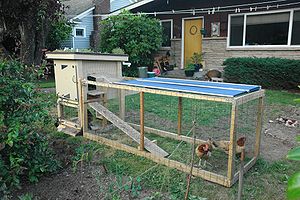 Two of the terrifying urban hens, caught on film. Image via Wikipedia
Two of the terrifying urban hens, caught on film. Image via Wikipedia
Underneath the arbor, a wooden box sways in the wind, acting as nest for the family's Mason bees.(Note that the roosters are unnecessary for egg production, so there's no need for them in urban/suburban settings.)The bees are good for the garden, Kim said. They pollinate the plants and are safe for the kids.
"They don't sting because there is no honey to protect," Kim said.
Dan built a hive for them out of a wooden block, drilled with holes that recess about four inches.
"(The female) fills it up with eggs, goes away and dies, and her little batch is born," Kim said.
Her other garden helpers are the 15 hens and three roosters who share the backyard.
"They are a major component of my gardening," Kim said. "We have one we call the gardener. As soon as you start digging in the soil, she will come to eat all the bugs."
The birds' insect-munching expertise comes in handy when Kim prepares a bed for replanting.
"I let them go and do whatever they want to do," she said. "When they're done, they move off and I plant my stuff and block them off."
She lets the fowl run loose in the yard every few days. They help to fertilize the grass and, in return, the hens lay roughly a dozen eggs a day. The yolks are a bright yellow and orange happy eggs from happy chickens, she added, with a smile and she sells the excess for $2 a dozen.

![Reblog this post [with Zemanta]](http://img.zemanta.com/reblog_e.png?x-id=fc1c1d34-bf44-43d1-8568-372e3d8446c4)




No comments:
Post a Comment